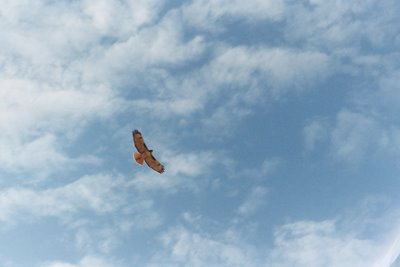Scheduled arrivals
So nary a post since March 10th? ¿Por que? What's kept me away from my on-line mirror (and off my bicycle) for so long has been the arrival of spring and the birds that accompany it. Since my last post, I've filled my birding journal with almost four pages of notes, representing seven trips afield. Actually, make that six field trips and one rather productive day on the patio out front.
In the list of birds sighted were seven or eight I'd never seen before; new ones for the life list. Most were seen at either the San Pedro Riparian National Conservation Area or the Coronado National Memorial near Sierra Vista, Arizona. The "SPRNCA" is a bona fide hotspot for birds, and every trip yields something exciting or new.
More important for me, or at least for my inner twitcher, however, were the additions I made to the list I keep for the house. I have a colleague who lives in suburban Glendale, Medio Arizona (the central province between Baja and Alta Arizona). His backyard list stands at ca. 90 avian species. True, his xeric landscape includes diverse and numerous specimens of bird-friendly native plants ( a "vagrant trap") and the surrounding suburban environs likely subsidize much forage for many species. But still, I'm at half his list and I live in west Tucson, Arizona; the outer fringes of a birding Mecca. I have a lot of watching yet to do. Regardless of how far behind I lag, the last week to ten-day period has yielded a few species I've not seen previously at (or from) my outpost, including:
Bullock's oriole (Icterus bullockii Linn.)
orange-crowned warbler (Vermivora celata Say)
Lucy's warbler (V. luciae Cooper)
black-throated gray warbler (Dendroica nigrescens Townsend)
Audubon's yellow rumped warbler (D. coronata Linn.)
zone-tailed hawk (Buteo albonotatus Kaup)
The oriole was a bird that had flashed through my field of view several times but always eluded identification. It was good to finally find the active, yet shy, Icterid taking a brief rest and get a lens on him. I was also fairly enthused by the four warblers, none of which are rare within their respective habitats, but which seldom frequent the xeric vegetation in the uplands where I live. The unusual passerines all seem drawn to the ocotillo blossoms that went off despite the complete cessation of rain a few weeks ago. Last year, the blossoms were magnets for migrant western tanagers (Piranga ludoviciana Wilson). Despite all of this dickie-bird activity, it was the big, black, diurnal raptor that generated the most excitement.
I've learned to scan every individual and/or group of birds on the off chance a novelty is in the mix. I've been putting my field glasses on the mourning (Zenaida macroura Linn.), white-winged (Z. asiatica Linn.), and Inca (Columbina inca Linn.) doves that mill about beneath our feeders on the off chance that a common ground (C. passerina Linn.) or ruddy (C. talpacoti Temminck) dove will show itself. Neither has, but I keep looking, just in case. Similarly, I try to look at every sparrow perched or in a flock, every raptor on the wing or in a kettle, and every duck in a raft; sometimes the good ones are hiding in plain sight.
Today, I saw a red-tailed hawk, likely the same subadult that's been around our neighborhood for many months, circling upward to challenge a turkey vulture (Cathartes aura Linn.). I've seen many red-tails and many more turkey vultures, but I've never seen the former harass the latter. As I glassed the two-bird vortex, I noticed they were roughly the same size. This was curious, as a "TV" is appreciably larger than even a mature female red-tailed hawk.
The turkey vulture turned, back to the sun, and revealed white bands across its tail - a field mark not of the vulture, but of the zone-tailed hawk. I've read and been told that zone-tails very much resemble turkey vultures, possessing similarly light-hued flight feathers and going so far as to emulate the dihedral wing posture and rocking flight of the scavenger. This mimicry is thought to enable the buteo to closely approach live prey that ordinarily wouldn't fear a soaring scavenger.
So here it was, a not-infrequent turkey vulture sighting from the front yard suddenly became a highly notable sighting of a buteo typically associated with riparian areas. The credit for the sighting, of course, goes to the red-tailed hawk who's infinitely sharper vision revealed not a harmless vulture, but a congeneric interloper. Its not enough to warrant the establishment of a full-time hawkwatch in the yard, but it sure made my day.
And for those keeping score, the red-tail drove the zone-tail away and claimed sole possession of the eastern sky.

Western red-tailed hawk (Buteo jamaicensis calurus Gmelin), light to intermediate form